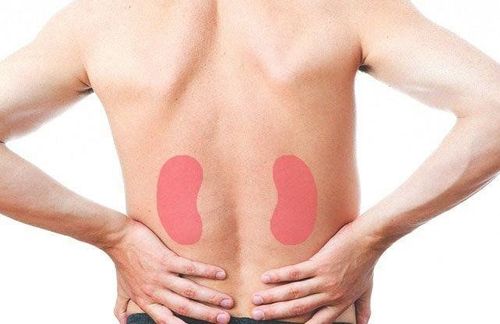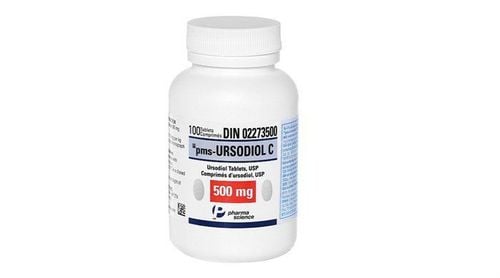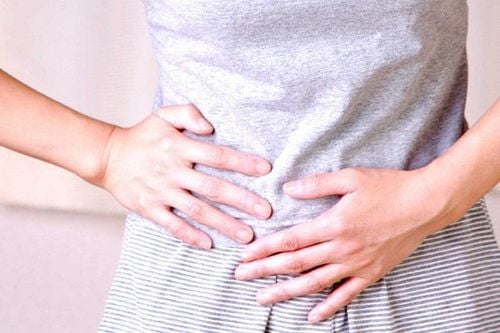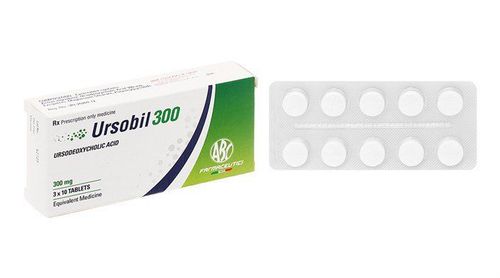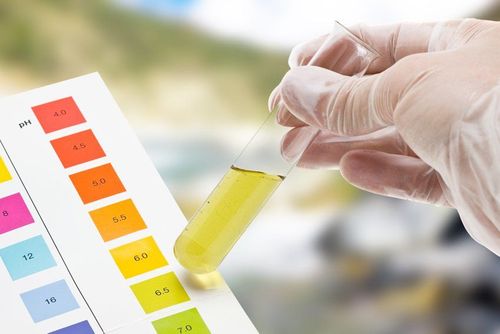This is an automatically translated article.
The article was professionally consulted with MSc Do Thi Hoang Ha - Doctor of Biochemistry, Laboratory Department - Vinmec Hai Phong International General Hospital.Urinalysis is one of the tests to check and evaluate health that is extremely important, simple but effective, and is indicated for general health examination and screening for many other diseases. Each parameter in this test has a certain meaning to reflect the health status of the body. The following article will help you understand the meaning of each of those parameters.
1. What is the volume of urine?
Normal urine volume in adults is 800-2000 ml/24 hours, equivalent to about 16-25 ml/kg body weight, with an average water intake of 2 liters/day. Urine volume can change from time to time, even from day to day, depending on health conditions, medical conditions (diabetes, diabetes insipidus, high fever, nephrotic syndrome). , diet, lifestyle, sweat, water intake, weather in the year..2. Characteristics of normal urine
2.1. What color is normal urine?
New and normal urine is clear or light yellow, at most amber or dark yellow, corresponding to its density. Dilute (low density) urine will be clear or very light yellow, concentrated (high density) urine will be dark yellow.The color of urine also depends on the amount of urine and the time of urination. If you drink less water and urinate for a long time, your urine will be darker in color. For example, the urine in the morning after waking up will be darker than the urine excreted during the day.
Some medical conditions have the ability to change the color of urine. For example, people with diabetes, liver disease will make the urine cloudy. Bacterial infections, upper urinary tract infections caused by pseudomonas or using certain drugs such as indomethacin, methocarbamol, methylene blue urine will appear blue or dark green. Bile pigment urine, methemoglobin, anticoagulants, levodopa urine will be brown or black. Using phenyltoin or phenothiazine will cause your urine to appear pink or burgundy.
Normal urine will be clear. To settle for a while, a cloudy layer will appear suspended in the middle or deposited at the bottom of the urinal. It is completely normal for urine to have sediment on the surface of the container. These are phosphate deposits, sodium urate or uric acid in the urine.
Urine tends to turn darker with long standing, so it is recommended that the sample be sent to the laboratory immediately after collection.
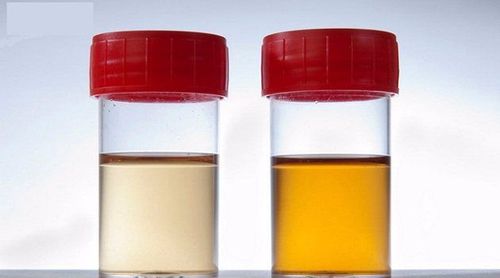
2.2. What does normal urine smell like?
The normal smell of urine is determined by its acidity. Normal urine has a slight odor, when left in the air for a long time, the odor will gradually thicken because the urea in the urine is converted into ammonia under the action of bacteria. A variety of medical conditions, medications, and foods can alter the smell of urine.With certain diseases, the patient's urine contains different odors such as bad smell, musty smell (eating garlic, phenylketonuria syndrome, urinary tract infection), flower smell. sweet fruit (acetoneuria), burnt sugar smell in maple syrup urine disease, acetone...
You should observe and monitor your urine daily. If you see urine with a different color and smell, cloudy, air bubbles, thicker than usual, it means that the body has abnormal signs, it is necessary to go for a urine test to check your health as soon as possible. good.
3. Meaning of parameters in urine test
What diseases can a urine test know? Through the urine test indicators, doctors can detect many diseases, especially diseases related to the urinary tract, hepatobiliary system, and blood sugar.3.1. Urine pH
Urine pH provides information regarding the patient's acid-base status. Normal urine in a healthy person is mildly acidic with a pH between 5.0 and 7.5. The common average pH is 5.0 - 6.0. If the pH ≤ 5 means the urine is strongly acidic, pH ≥ 8 means the urine is basic. It was found that there was an inverse correlation between urine pH and urinary ketone concentration.Urine acidity is high or low due to the concentration of free acids present in the urine. In it, the kidney plays a role in balancing the amount of acids and bases. So through the pH we can check kidney function, diagnose kidney diseases. For example:
pH ≥ 8 can cause cystitis, pyelonephritis, metabolic or respiratory alkalosis, Falconi syndrome .. Low pH, highly acidic urine can appear in diabetes diabetes, dehydration, diarrhea, metabolic acidosis, fever... In addition, stomach diseases can also be detected through the pH of urine. Certain foods and medications can also change the pH of your urine.
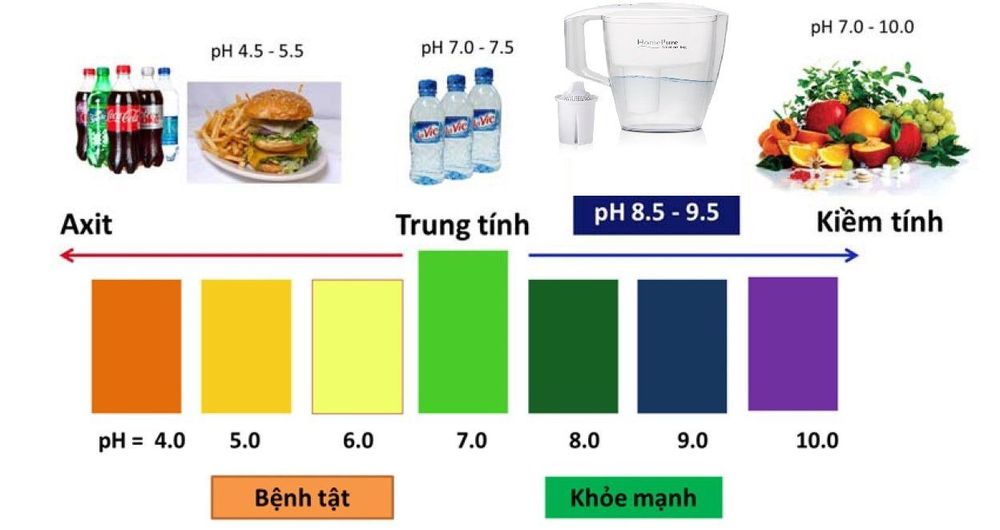
3.2. White blood cells
This is essentially a white blood cell esterase that is released by white blood cells when bacteria are present in the urine. The white blood cell count in normal urine in healthy adults is negative or traceable (10 Leu/UL). This test is very sensitive, if leukocytes are present in the urine, further clinical symptoms and other tests (eg, urine culture) are needed to determine if a urinary tract infection is indeed present. or not. If the white blood cell count increases, accompanied by symptoms of painful urination, frequent urination, you may have a urinary tract infection caused by a fungal or bacterial infection, a bladder infection...3.3. Nitrites
Normally, there is no nitrite in the urine, or if it is, it is very low. The allowable nitrite index in urine is 0.05-0.1 mg/dL. Nitrite is formed by bacteria metabolizing nitrates, which are derived from metabolites found in nutrients, which are normally found in the body. The presence of nitrite means bacteria may be attacking the body, especially gram-negative bacteria that cause urinary tract infections. In which, the most common type is E. Coli infection. This test is used in combination with a leukocyte esterase to help screen for the presence of bacteria in the urinalysis test.It is possible to test for nitrites in the urine using test strips. If the test strip turns pink or light pink, it means that the urine contains nitrites and bacteria. The recommended urine sample is the first urine sample in the morning.
3.4. The protein
The allowable protein index in urine is negative or traceable for people with normal kidney function (equivalent to 7.5-20mg/dL or 0.075-0.1g/L). This is because the glomerular membrane does not allow large protein molecules to pass through. In case of kidney dysfunction, damage to the glomerular filter allows proteins to pass through and appear in the urine. Therefore, through the protein index, it is possible to detect kidney diseases, determine whether the patient has an infection (pyelonephritis)..To test the exact protein index, it is necessary to use urine. in the morning, the first time urinating after waking up.
3.5. Glucose
In healthy people, after being filtered by the kidneys, glucose is reabsorbed in the proximal tubules. There is a "renal threshold" for each person's glucose, and when that person has blood glucose levels below the "threshold" there will be no glucose in the urine, or if so, very little for a woman during pregnancy. . The permissible value of glucose is 50-100 mg/dL or 2.5-5 mmol/L. If the urine test detects that there is or much glucose in the urine, then it is likely that you have diabetes, acute pancreatitis, kidney problems, Falconi syndrome, galactose intolerance, Cushing's syndrome, infection..Some drugs can cause false negatives or false positives in urine samples (ascorbic acid, cephalosporins, chloramphenicol..)
3.6. Ketones (KET_Ketones)
Ketones form due to the metabolism of fatty acids as an energy source when the body lacks glucose or in uncontrolled diabetes (insulin deficiency). Normal urine of a healthy person has no or very little ketones. Permissible index: 2.5-5 mg/dL or 0.25-0.5 mmol/L.Therefore, when the ketotic index increases, it means that there is a problem with glucose metabolism or helps to evaluate the conditions that cause ketoacidosis when fasting for a long time or as a side effect of some drugs.
3.7. Urobilinogen
Urobilinogen is converted from bilirubin directly by enteric bacteria in the duodenum, a large part is excreted in the feces, a part is returned to the bile, and only a very small amount is excreted in the urine. The allowable index of urobilinogen in urine is 0.2-1.0 Ehrlich units/dL or 3.5-17 mmol/L. If the urine test shows an increased amount of urobilinogen, it is possible to have liver and gallbladder diseases such as cirrhosis, hepatitis, biliary obstruction...3.8. Bilirubin
Under normal conditions, bilirubin is not detected in the urine because it is converted to urobilinogen in the intestine. An increase in the amount of bilirubin in the urine is a warning of liver and gallbladder diseases because direct bilirubin is then unable to pass through the intestines, back into the blood, filtered by the kidneys, and excreted in the urine. The allowable index of bilirubin in the urine: not more than 0.2 mg/dL (<0.34 umol/l).3.9. Red blood cells
Normally there are no or very few red blood cells in the urine. The permissible value of red blood cells in the urine is 0.015-0.062 mg/dL or 5-10 Ery/ UL. If a urinalysis detects high levels of red blood cells in the urine, this is an abnormal sign of the body, usually related to an infection or damage to the urinary tract such as urinary tract infection, kidney stones. , kidney tumor, bladder bleeding...3.10. Ascorbic Acid
Ascorbic acid is an essential vitamin of the body, supporting the functioning of bones, joints, blood vessels and increasing resistance. Ascorbic acid is an antioxidant, so it can interfere with urine test results. Normal urine ascorbic acid levels measured by test strips are negative. If the amount of ascorbic acid in the urine exceeds the allowable index by 5-10 mg/dL or 0.28-0.56 mmol/L, it can identify pathologies of kidney function. High concentrations of ascorbic acid can also cause false negatives for the test strip determination of glucose, blood, white blood cells, nitrite and bilirubin.4. Does the urine test require fasting?
Nutrients in food can change some of the urine parameters. The nitrite test requires a minimum time of urine in the bladder ≥ 3.5 hours. Therefore, for more accurate test results, you should fast for 6-8 hours before taking the urine test. It is advisable to collect urine first thing in the morning so that food can be fully digested during sleep at night.Please dial HOTLINE for more information or register for an appointment HERE. Download MyVinmec app to make appointments faster and to manage your bookings easily.
Articles compiled from the source: Quy Nhon Institute of Malaria, Parasites and Insects




